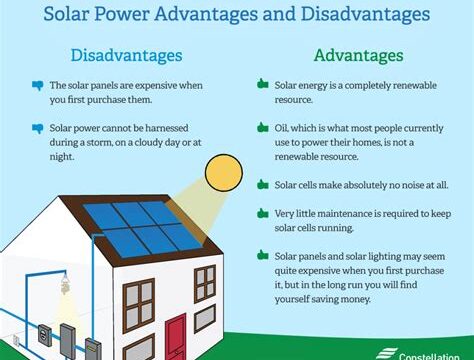Renewable and Sustainable Power Source
Renewable energy is a power source that is derived from natural resources that replenish themselves over time. Unlike fossil fuels, such as coal or oil, which are finite and will eventually be depleted, renewable energy offers a sustainable solution for meeting our energy needs. This type of power source includes various forms such as solar, wind, hydro, and geothermal energy. By harnessing these abundant and clean resources, we can reduce our dependence on fossil fuels and mitigate the negative impacts of climate change.
One of the key advantages of renewable energy is its positive contribution to reducing greenhouse gas emissions. Burning fossil fuels releases carbon dioxide and other harmful pollutants into the atmosphere, contributing to the greenhouse effect and climate change. In contrast, renewable energy sources produce little to no greenhouse gas emissions during their operation. Switching to renewable energy can significantly help in reducing our carbon footprint and mitigating the adverse effects of global warming.
Moreover, renewable energy offers low operating costs and the potential for long-term savings. While the initial investment for installing renewable energy systems may be higher compared to traditional fossil fuel power plants, the ongoing costs of fuel and maintenance are typically much lower. Renewable energy systems also have a longer lifespan, resulting in significant long-term savings. Additionally, as technology advances and economies of scale improve, the cost of renewable energy continues to decrease, making it increasingly affordable for both households and businesses.
- Renewable energy sources:
- Solar energy
- Wind energy
- Hydro energy
- Geothermal energy
| Advantages of Renewable Energy |
|---|
| Emission reduction |
| Low operating costs |
| Long-term savings |
Another critical aspect of renewable energy is its positive impact on energy independence and security. Reliance on fossil fuel imports can make a country vulnerable to geopolitical risks and price volatility. However, by embracing renewable energy sources that are abundant within a country’s own borders, nations can reduce their dependence on external energy sources and enhance their energy security. This not only strengthens a nation’s autonomy but also reduces the risk of energy supply disruption.
The growth of the renewable energy sector also leads to job creation and economic growth. The transition to renewable energy requires a skilled workforce for the design, installation, and maintenance of renewable energy systems. As more renewable energy projects are developed, they generate new employment opportunities across various sectors, including manufacturing, construction, and research. Moreover, investing in renewable energy stimulates economic growth by attracting investments, supporting local businesses, and fostering innovation.
Renewable energy systems also offer minimal maintenance requirements and high reliability. Unlike traditional power plants, which often require extensive maintenance and frequent repairs, renewable energy systems are designed for durability and have longer operational lifetimes. Many renewable energy technologies have no moving parts, reducing the risk of mechanical failures and breakdowns. This ensures a more reliable and consistent power supply, which is crucial for supporting critical infrastructures, residential electricity needs, and industrial operations.
The applications of renewable energy are diverse and can be implemented across various sectors. Renewable energy can power homes, businesses, and industries, reducing the reliance on fossil fuels and promoting a cleaner and more sustainable energy mix. Additionally, renewable energy can be integrated into transportation systems through electric vehicles and charging infrastructure, further contributing to the reduction of greenhouse gas emissions and air pollution. Expanding the deployment of renewable energy technologies in sectors such as agriculture, healthcare, and education can also have positive social and environmental impacts.
In conclusion, renewable energy represents a sustainable and environmentally friendly power source that offers numerous benefits. It reduces greenhouse gas emissions, provides cost savings and long-term financial advantages, enhances energy independence and security, contributes to job creation and economic growth, requires minimal maintenance, and has diverse applications across multiple sectors. By harnessing the power of renewable energy, we can create a greener and more sustainable future for generations to come.
Reduces Greenhouse Gas Emissions
When it comes to addressing climate change and global warming, one of the key factors to consider is the reduction of greenhouse gas emissions. Greenhouse gases, such as carbon dioxide, methane, and nitrous oxide, trap heat in the Earth’s atmosphere and contribute to the warming of our planet. Finding ways to reduce these emissions is crucial in mitigating the impacts of climate change and preserving the environment for future generations.
Renewable and sustainable power sources play a vital role in reducing greenhouse gas emissions. Unlike fossil fuels, which release large amounts of carbon dioxide when burned, renewable energy sources, such as solar, wind, and hydroelectric power, produce little to no greenhouse gas emissions during their operation. By transitioning to a more sustainable energy mix, we can significantly reduce our carbon footprint and make a positive impact on the environment.
In addition to reducing greenhouse gas emissions, embracing renewable energy sources brings low operating costs and long-term savings. While the initial investment for installing renewable energy systems may seem high, the long-term savings are considerable. Solar panels, for example, have a lifespan of 25-30 years and can significantly reduce or even eliminate electricity bills. Switching to renewable energy not only helps the environment but also provides financial benefits to individuals, businesses, and communities.
- Renewable energy sources reduce greenhouse gas emissions
- Renewable energy brings low operating costs and long-term savings
- Transitioning to sustainable power sources ensures energy independence and security
- Renewable energy promotes job creation and economic growth
- Renewable energy systems require minimal maintenance and offer reliable operations
- Renewable energy has diverse applications in various sectors
- Renewable energy has a positive impact on public health and the environment
| Advantages of Renewable Energy | Disadvantages of Fossil Fuels |
|---|---|
| Reduces greenhouse gas emissions | Contributes to climate change |
| Low operating costs and long-term savings | Finite resource, leads to resource depletion |
| Ensures energy independence and security | Reliance on foreign oil |
| Creates job opportunities and stimulates economic growth | Environmental pollution and health risks |
| Requires minimal maintenance and offers reliable operations | Environmental damage from extraction and transportation |
| Diverse applications in various sectors | Price volatility and market uncertainties |
| Improves public health and the environment | Accidents and disasters related to fossil fuel extraction |
Embracing renewable energy sources is essential for our future. By reducing greenhouse gas emissions, we can combat climate change and protect the environment for generations to come. The advantages of renewable energy, such as low operating costs, energy independence, and job creation, make it a viable and sustainable solution. Together, let’s take the necessary steps toward a cleaner, greener, and healthier planet.
Low Operating Costs and Long-Term Savings
One of the major advantages of utilizing renewable and sustainable power sources is the low operating costs and long-term savings it offers. Unlike traditional energy sources such as fossil fuels, renewable power sources like solar or wind energy require minimal ongoing expenses once the initial setup is complete. This is because they rely on natural resources that are freely available and do not require constant replenishment or costly extraction processes.
In addition to low operating costs, renewable power sources also provide long-term savings. As the world becomes more financially conscious, the financial benefits of renewable energy are becoming increasingly apparent. Investing in renewable energy systems allows individuals and organizations to reduce their reliance on fossil fuels, which are subject to price fluctuations and geopolitical factors. By transitioning to renewable energy sources, individuals and organizations can establish a stable and predictable energy budget, ultimately leading to significant long-term savings.
Furthermore, the use of renewable and sustainable power sources not only benefits individual households but also offers substantial savings for businesses and industries. By adopting renewable energy systems, businesses can significantly reduce their operational costs, allowing them to allocate their financial resources to other essential areas of their operations. Moreover, the long-term savings resulting from lower energy bills can contribute to the overall economic growth of the organization and create opportunities for job creation.
- Reduced energy costs
- Stable and predictable energy budget
- Financial benefits for businesses and industries
- Opportunities for job creation
| Renewable and Sustainable Power Sources | Low Operating Costs and Long-Term Savings |
|---|---|
| Hydroelectric Power | Significantly lower operating costs compared to traditional power plants |
| Solar Energy | Minimal ongoing expenses once the initial setup is complete |
| Wind Power | Long-term savings from reduced reliance on fluctuating fossil fuel prices |
Energy Independence and Security
Energy independence and security are crucial factors when it comes to the sustainability and resilience of a nation’s power supply. As global concerns about the depletion of finite fossil fuel resources and the volatility of oil prices continue to rise, the need to diversify our energy sources and reduce reliance on external suppliers becomes increasingly apparent. With the rapid advancement of renewable energy technologies, achieving energy independence and security has become not only feasible but also economically beneficial.
One of the key advantages of renewable energy sources is their ability to rely on domestically available resources. Unlike fossil fuels that often need to be imported from other countries, renewable energy sources such as solar, wind, and hydroelectric power can be harnessed within a nation’s own boundaries. By tapping into indigenous renewable resources, countries can reduce their dependence on foreign energy sources, enhance energy security, and mitigate the risks associated with uncertain geopolitical dynamics.
In addition to reducing reliance on external suppliers, renewable energy technologies also offer increased energy security by diversifying the energy mix. By incorporating a variety of renewable sources into the energy portfolio, countries can minimize the vulnerability associated with disruptions in a single energy source. For instance, a significant disruption in oil supply due to geopolitical conflicts or natural disasters can lead to severe energy shocks and economic instability. However, with a diversified mix that includes renewable sources, a nation can better withstand such shocks and ensure a more stable and secure energy supply.
Furthermore, the transition towards renewable energy not only bolsters energy independence and security but also contributes to environmental sustainability. Renewable sources produce little to no greenhouse gas emissions, reducing the carbon footprint and mitigating climate change. This dual benefit of renewable energy – enhancing energy security while combatting climate change – makes it a compelling solution for governments and policymakers worldwide.
In conclusion, achieving energy independence and security is a vital objective for any nation seeking to secure its energy supply in the long term. Renewable energy sources enable countries to rely on domestically available resources, diversify their energy mix, and reduce greenhouse gas emissions. This transition not only enhances energy security but also contributes to environmental sustainability. By leveraging the numerous advantages of renewable energy, governments can ensure a resilient energy future, both economically and environmentally.
Job Creation and Economic Growth
One of the significant benefits of renewable and sustainable power sources is their ability to stimulate job creation and contribute to economic growth. As the world continues to transition towards clean energy alternatives, the demand for skilled workers in the renewable energy sector has been steadily increasing. This surge in employment opportunities is not limited to traditional energy-producing regions but extends to various sectors, including manufacturing, construction, and research and development.
The shift towards renewable energy sources can create a ripple effect throughout the economy, generating new job avenues and strengthening local communities. For example, the installation and maintenance of renewable energy systems require a skilled workforce, leading to the creation of specialized jobs such as solar panel installers, wind turbine technicians, and energy auditors. Additionally, the manufacturing and supply chain sectors experience growth due to the increased production and distribution of renewable energy technologies. These activities create a multiplier effect, stimulating economic growth by boosting local businesses and generating tax revenue for governments.
Not only does the renewable energy sector offer employment opportunities, but it also promotes economic growth by reducing dependency on fossil fuels. As countries decrease their reliance on non-renewable energy sources, they become less vulnerable to price fluctuations in the global oil and gas markets. Investing in renewable energy projects and technologies also bolsters national energy security by diversifying the energy mix and reducing the risk of supply disruptions. This increased stability and predictability in energy costs create favorable conditions for businesses to flourish, attract investments, and expand their operations, resulting in economic growth and prosperity.
Moreover, the transition to clean energy sources is often accompanied by innovation and technological advancements. As governments and private entities invest in renewable energy research and development, they spur innovation, which leads to the creation of new industries and job opportunities. For instance, the development of more efficient solar panels or advanced energy storage systems not only drives employment in the renewable energy sector but also provides avenues for technology-focused companies to emerge.
- Renewable energy stimulates job creation in various sectors, including manufacturing, construction, and research and development.
- It creates specialized job roles such as solar panel installers, wind turbine technicians, and energy auditors.
- The manufacturing and supply chain sectors experience growth due to increased production and distribution of renewable energy technologies.
| Benefits of Job Creation and Economic Growth in the Renewable Energy Sector: |
|---|
| 1. Reduces dependency on fossil fuels and vulnerability to price fluctuations. |
| 2. Promotes national energy security and stability. |
| 3. Drives innovation and technological advancements. |
Minimal Maintenance and Reliability
When it comes to choosing a power source, one important factor to consider is the minimal maintenance and reliability it offers. With traditional power sources, such as fossil fuels, regular maintenance is required to ensure their proper functioning. This not only adds to the overall operational costs but also increases the chances of downtime and disruptions in power supply. On the other hand, renewable and sustainable power sources offer a solution to these issues.
Renewable and sustainable power sources, such as solar and wind energy, require minimal maintenance once they are set up and operational. The systems are designed to be durable and reliable, minimizing the need for frequent repairs and replacements. This not only reduces the overall costs associated with maintenance but also ensures a more consistent and uninterrupted power supply. With proper installation and regular inspections, renewable power sources can continue to operate efficiently for decades.
The reliability of renewable power sources is another key advantage. Unlike traditional power sources that are often subject to price fluctuations and supply chain disruptions, renewable energy is derived from natural resources that are abundant and accessible. The sun will continue to shine, and the wind will keep blowing, making renewable power sources a reliable and consistent option.
- Minimal maintenance leads to reduced operational costs.
- Renewable power sources are designed to be durable and reliable.
- Regular inspections ensure efficient and uninterrupted power supply.
- Renewable energy is derived from abundant and accessible natural resources.
- Reliability of renewable power sources provides long-term stability.
| Advantages | Disadvantages |
|---|---|
| Minimal maintenance | Initial setup costs |
| Reliability | Intermittent nature (in the case of solar and wind energy) |
| Reduced operational costs | Dependence on suitable environmental conditions |
| Long-term stability |
Diverse Applications in Various Sectors
Renewable and sustainable power sources have the advantage of being applicable in numerous sectors, making them incredibly versatile and adaptable. Whether it’s powering residential homes, commercial buildings, or industrial facilities, renewable energy solutions offer a wide range of possibilities. The use of solar power, wind energy, hydropower, and geothermal energy can be harnessed to generate electricity for both urban and rural areas. Additionally, renewable energy can be integrated into transportation systems, providing clean and efficient modes of travel. These diverse applications make renewable power sources an ideal solution for any sector that requires energy.
The use of renewable energy also extends to the agricultural sector, where farmers and ranchers can benefit from harnessing renewable power sources. By utilizing solar energy or wind power, farmers can power irrigation systems, operate machinery, and even store excess energy for future use. This reduces their dependence on fossil fuels and mitigates the environmental impact associated with traditional farming practices.
Moreover, renewable energy plays a vital role in the healthcare sector as well. Hospitals and medical facilities require a constant and reliable energy supply to operate critical equipment, maintain temperature control, and provide lighting. Renewable power sources provide a sustainable and resilient solution, ensuring seamless operations even during power outages or natural disasters.
- Residential buildings
- Commercial establishments
- Industrial sectors
- Transportation systems
- Agricultural practices
- Healthcare facilities
| Sector | Advantages of Renewable Energy |
|---|---|
| Residential buildings | Reduced electricity bills and carbon footprint |
| Commercial establishments | Cost savings, positive brand image, and sustainability commitment |
| Industrial sectors | Operational cost reduction, increased efficiency, and regulatory compliance |
| Transportation systems | Lower fuel costs, decreased emissions, and energy independence |
| Agricultural practices | Lower energy expenses, environmental protection, and self-sufficiency |
| Healthcare facilities | Reliable power supply, enhanced resilience, and reduced carbon footprint |
Positive Impact on Public Health and Environment
A positive impact on public health and the environment is one of the many benefits of adopting renewable and sustainable power sources. Fossil fuels and traditional energy sources have been found to contribute to air pollution, climate change, and various health issues. By transitioning to renewable energy sources such as solar, wind, hydro, and geothermal power, we can significantly reduce emissions and improve both the well-being of individuals and the overall health of our planet.
One major advantage of renewable energy is the significant reduction in harmful greenhouse gas emissions. Fossil fuel combustion releases greenhouse gases such as carbon dioxide (CO2), methane (CH4), and nitrous oxide (N2O) into the atmosphere. These gases trap heat and contribute to the warming of our planet, leading to the adverse effects of climate change. By utilizing renewable energy sources, we can greatly minimize the release of these gases, mitigating climate change and its associated impacts.
In addition to reducing greenhouse gas emissions, renewable energy sources also have low operating costs and offer long-term savings. While the initial setup and installation of renewable energy systems may require a significant investment, the cost of fuel and maintenance is considerably lower compared to traditional power plants. Once installed, renewable energy systems can generate electricity for many years without the need for expensive and polluting fuel sources, resulting in long-term cost savings for both individuals and businesses.
- Rapid technological advancements in renewable energy technologies have contributed to their increasing affordability and accessibility.
- Government incentives and subsidies further encourage the adoption of renewable energy systems by reducing the upfront costs.
- As the demand for renewable energy continues to rise, economies of scale will further drive down costs.
Energy independence and security are crucial advantages of renewable and sustainable power sources. By diversifying our energy mix and reducing dependence on imported fossil fuels, countries can enhance their energy security and reduce vulnerability to geopolitical tensions and price fluctuations. Renewables, like solar and wind, can be harnessed locally and are available in abundance in many regions, providing an opportunity for countries to gain energy independence and strengthen their national security.
| Benefits of Renewable Energy | Description |
|---|---|
| 1. Reduced air pollution | Renewable energy sources produce little to no air pollutants, improving air quality and reducing respiratory issues. |
| 2. Reduced water pollution | Unlike traditional power plants, renewable energy systems do not produce harmful wastewater or pollute water sources. |
| 3. Improved public health | By reducing air and water pollution, renewable energy contributes to better public health outcomes and lowers healthcare costs. |
| 4. Conservation of natural resources | Renewable energy relies on sustainable resources like sunlight, wind, and water, which can be replenished naturally. |
The diverse applications of renewable energy across various sectors further contribute to its positive impact on public health and the environment. From powering homes and businesses to providing clean energy for transportation and industry, renewables offer versatile solutions for reducing emissions and mitigating the negative environmental impacts associated with conventional energy sources. Continued innovation and investment in renewable technologies will lead to even greater advancements and broader implementation across these sectors.
Frequently Asked Questions
What is a renewable and sustainable power source?
A renewable and sustainable power source is a type of energy that is generated from resources that are naturally replenished, such as sunlight, wind, water, and biomass. These sources of energy do not deplete over time and have a minimal impact on the environment.
How does a renewable power source reduce greenhouse gas emissions?
A renewable power source emits significantly fewer greenhouse gases compared to traditional fossil fuel-based energy sources. For example, solar power and wind power generate electricity without the release of harmful emissions, contributing to a reduction in overall carbon dioxide and other greenhouse gas emissions.
What are the operating costs and long-term savings associated with renewable power sources?
The operating costs of renewable power sources are generally lower than those of conventional power sources. Once the initial installation and setup costs are covered, the ongoing costs of generating electricity from renewable sources, such as solar panels or wind turbines, are minimal. Additionally, renewable power sources can provide long-term savings as they are not subject to fluctuating fuel costs.
How does renewable power contribute to energy independence and security?
By diversifying the energy mix and reducing dependence on imported fossil fuels, renewable power sources contribute to energy independence and security. Unlike finite fossil fuel resources, renewable energy sources are domestically available and can help countries reduce their reliance on foreign energy sources, enhancing their energy independence and security.
How does renewable power creation lead to job creation and economic growth?
The development and expansion of renewable power sources often lead to job creation and economic growth. As the demand for renewable energy technologies, such as solar panels or wind turbines, increases, new job opportunities are created in manufacturing, installation, maintenance, and research. Moreover, the renewable energy sector can attract investments and stimulate economic development in local communities.
Why do renewable power sources require minimal maintenance and offer reliability?
Renewable power sources, such as solar or wind energy systems, generally require minimal maintenance once installed. Solar panels and wind turbines have fewer moving parts compared to traditional power generation equipment, resulting in decreased maintenance requirements. Additionally, renewable power sources are reliable as they are not subject to supply disruptions caused by global fuel markets or geopolitical factors.
What are the diverse applications of renewable power sources across various sectors?
Renewable power sources have diverse applications across various sectors, including residential, commercial, and industrial. They can be used to generate electricity for homes, businesses, and factories. Additionally, renewable energy technologies can power transportation systems and provide clean energy for agriculture, water desalination, and remote off-grid locations.





